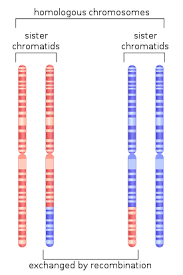HOMOLOGOUS CHROMOSOMES- KEY FEATURES
DEFINITION
Homologous chromosomes are a set of one maternal and one paternal chromosome which makes pairing with each other within a cell during gamete formation.
Pairing of homologous chromosomes is known as Synapsis.
FEATURES
- Such chromosomes are made up of chromosome pairs having more or less the same length, centromere position, and staining pattern, for genes with the same corresponding loci. Thus, when two chromosomes of the exact structure exist, they are able to pair together to form homologous chromosomes.
- One homologous chromosome is inherited from the organism’s mother, while the other is inherited from the organism’s father.
- In diploid (2n) organisms, the genome is composed of one set of each homologous chromosome pair. For example human cell contains 23 pairs of homologous chromosomes.
- While each homologous chromosome carries the same genes, they can carry different versions of the gene. Different versions of a gene are called alleles.
Read also…
DIFFERENCE BETWEEN GENE AND ALLELE - The mixing of maternal and paternal traits is enhanced by crossing over during meiosis, wherein non-sister chromatids of homologous chromosomes exchange genetic material.

FUNCTION
They lead to recombination and random segregation of genetic material from the parents into new cells. Therefore they are important in the process of mitosis and meiosis both means main function is their use in nuclear division.
Read more..
WHAT IS CHROMOSOME- AN OVERVIEW
TYPES OF CHROMOSOME-STRUCTURE&DEFINITION
MENDEL’S LAW OF INHERITANCE
DIFFERENCE BETWEEN GENE AND ALLELE
CROSSING OVER- PROCESS & FUNCTION
SYNAPSIS MEANING- PROCESS & FUNCTION
DIFFERENCE BETWEEN PROKARYOTIC AND EUKARYOTIC CELLS
DIFFERENCE BETWEEN PLANT CELL AND ANIMAL CELL
MITOSIS & MEIOSIS- CELL DIVISION
CELL STRUCTURE AND FUNCTION